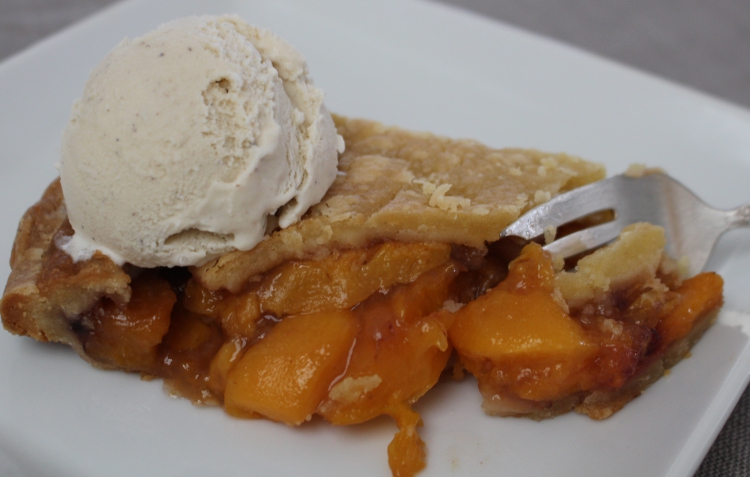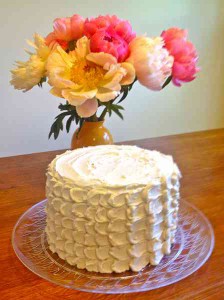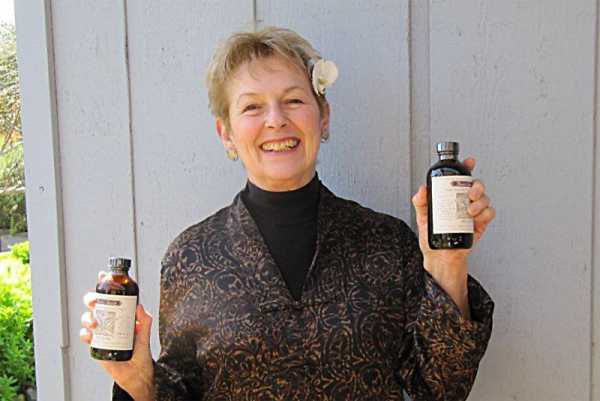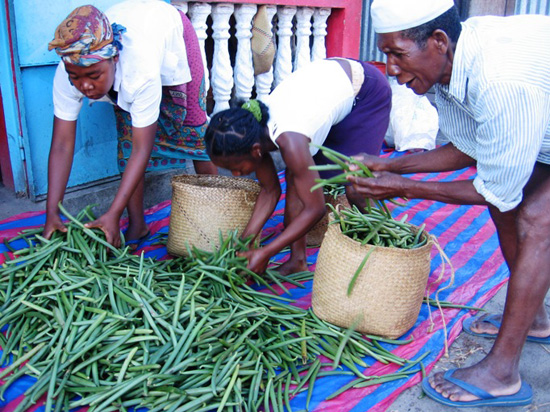
I'm amazed at how superior your vanilla is!
– Des, The Grommet

Pastry Chef, Nancy Kux, ran a bakery, Nancy’s Fancies, for many years. She is an active member in many culinary groups, including the San Francisco chapter of the Baker’s Dozen where she has served as President and mentor to many.
Recently Nancy provided a guide for preparing a cake for frosting as well as effective frosting techniques for the Baker’s Dozen. I was impressed by the thoroughness of her guide and invited her to share her article with us at The Vanilla Company. She readily agreed and added even more information. I hope you will find this useful. I know that I did.
Preparing a Cake to be Frosted
When baking a cake that is to be frosted, I would bake it at least 10 hours or more before frosting it, giving it time to cool completely and to firm up. Cake flour produces a more delicate cake, but you can use other flour if you prefer.
I never liked baking a really tall cake and then slicing it into layers. I preferred to bake it in two or three pans. Just adjust the baking time accordingly. I always set my timer for less time than a recipe calls for to make sure I don’t overbake the cakes. Then I make a note on the recipe of the actual time it required to bake it.
I always use parchment paper. This prevents the middle of the cake from remaining in the pan when you depan it. If the cake is to be frosted, I never butter (or grease) the pans.
You can cool cakes much longer than 10 minutes. When you are ready, run a thin knife around the edges to release the cakes. When the cakes are cool they usually will not fall apart when you depan them. If the cakes are very fragile, cut a cardboard round just smaller than the pan and put it on top of the layer so you can depan it on top cardboard, thereby side-stepping the drop to a cake plate.
At my bakery we also put cake crumbs on the tops of the layers before depanning them to prevent the “wet” tops from sticking to the cardboard if they needed to be moved.
We depanned, when possible, onto the serving surface. Then we put the layers, paper-to-paper on top of each other and wrapped them well in plastic and froze them. Instead of freezing, you can wrap them, leave them in a cool place, and frost them the following day. It is much easier to frost a cooled and “set” cake.
Don’t remove the papers separating the layers until you are ready to fill and frost the cake. Make sure that your crumb-coat frosting is quite soft, making it easier to spread. With a soft crumb-coat frosting, you will also avoid tearing the cake.
Three stages to Frosting a Cake
If you are using an Italian meringue buttercream, I suggest you allow it first to age for a day in the refrigerator.
When you are ready to frost, the first step is a crumb-coating. This keeps crumbs from showing under the finished frosting.
Pile chunks of the cold, firm buttercream into a mixing bowl. Fill a pot that is large enough to hold the mixing bowl with water and bring the water to a boil. Put the mixing bowl into the water so that the water level is one-third to one-half of the way up the side of the bowl. When about one-third of the buttercream has melted, remove the bowl from the water bath and place it on a mixer stand. Cover the bowl with a kitchen towel to prevent splashes from the bowl.
Using a paddle attachment, mix the chunks of buttercream on low speed until the mixture is smooth and the consistency of mayonnaise. If it is too stiff, warm it in the water bath and repeat mixing. Keep air bubbles to a minimum by using only low speed. Cold buttercream may look curdled; don’t worry, it will smooth out.
It’s worth purchasing a turntable for frosting cakes. An inexpensive Rubbermaid one will do, or invest in a professional one. Determine the best height for you before starting the frosting. I’ve used phone books to adjust the height to make frosting cakes easier.
The first step will be to apply a thin coat of buttercream to lock in the crumbs. This is easier if the cake is cold so that the buttercream chills as you smooth it all over the cake. Once it’s applied, refrigerate the cake. This will make the next (and final) coat of buttercream much easier to apply and you will be able to cover the cake without worrying about crumbs showing through.
The final coat of frosting should be applied after you have refrigerated the cake to keep the crumbs securely locked in. Again, the frosting should be the consistency of mayonnaise. With a cold cake, the frosting will chill properly and still make it easy to spread.
When the buttercream on the cake has set and is cold, it’s time for the final coat. Start by piling a lot of buttercream on the top of the cake, and push and spread the frosting evenly toward the sides. Think of the hands of a clock: Start at the center and spread to 12 o’clock and repeat to 2, 4, 6, 8, 10. The frosting should stay just hovering at the edge of the top. Now, starting at 12, gently let the frosting fall down the side of the cake. Spread it just an inch or two, spreading from the top to the bottom of the side. Repeat at each interval. Do not attempt to spread more than an inch or two at a time.
When the entire cake is covered, begin to even out the butter cream. Start at the top. Slowly spin the cake and remove some frosting by holding the spatula blade at a 45 degree angle to the cake as you hold the spatual perpendicularly to the cake top. Remove some of the frosting, clean off the blade and repeat. To remove the excess buttercream from the side, hold the spatula straight up and down, with the blade at the 45 degree angle to the side. Again, remove just a small amount, clean the blade and continue. Then slowly spin the cake as you smooth the side in one complete spin. Refrigerate the cake again.
Refrigerate the cake again so that you can scrape the sides and tops to make it really smooth, if that is the look you want. Or, you can cover the sides with nuts or coconut, or use a comb or spatula to create a textured finish.
If the goal is to have an extremely smooth finish, chill the cake so that the buttercream will work well. Just like the above instructions, smooth small portions of the top and sides by shaving off the little bits of extra buttercream and covering some air bubbles. You must remember to clean the blade to avoid a spackled look. This takes practice.
Add borders or decorations once the cake is completely smooth.
The cake should be served at room temperature to allow the full flavor of the cake and frosting to come through.
The above directions are almost the same with other frostings. However, powdered sugar has cornstarch in it, which can make the powdered sugar frostings dry out and harden. When you are at the third step, smooth the finish with a hot spatula to melt the frosting instead of scraping it. This will help you with the goal of achieving a beautifully smooth cake.
I was given a small bottle of Rain’s Choice in a gift basket and I have been hooked ever since. The flavor makes all of my baking so much better! I will never use grocery store vanilla again!


© 2021. All Rights Reserved
Designed/Developed by Kat & Mouse
2 Responses
Thank you!
I make a banana nut cake and whipped frosting. I use a flour, milk paste with sugar, vanilla for the frosting. I will cool cake in refrigerator and make frosting the next day. In the past I was too rushed and made everything in one day. Sometimes frosting was not whipping up. Thank you for the tips.
You’re welcome Marge. Happy Baking!
Patricia